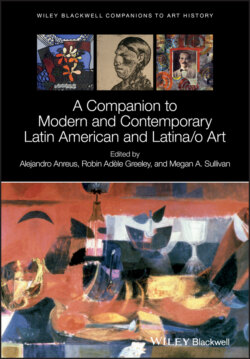Читать книгу A Companion to Modern and Contemporary Latin American and Latina/o Art - Группа авторов - Страница 60
7 The Oscillation Between Myth and Criticism: Octavio Paz Between Duchamp and Tamayo
ОглавлениеCuauhtémoc Medina
*
* *
In a country such as Mexico where the writer, at least until the end of the twentieth century, functioned as a general cultural administrator, even more than did scholars, theoreticians, and specialists, it seems almost pointless to trace the boundaries between writing and art criticism. Some might even say that by introducing the differentiation I am simply rehashing the disqualification of “poetic criticism” by Latin American theoretical critics back in the 1970s. Or (even worse) that I am attempting to force a colonial assimilation onto the periphery by projecting a series of purely metropolitan conditions, including the integration of criticism into the mechanisms of a developed art market, the full‐time marketing operations of a specialized press, even the assumption that criticism is itself an artistic creation mediated by the refinement of audiences.
My intention is quite different. I propose a certain historical maneuver whereby I redeem a small part of the disparaged local “poetic” criticism – or to be precise, criticism written by poets – that becomes meaningful only once it is restored to all its eccentricity. In other words, I am attempting to restore the relative folly of a critical operation, a moment of misunderstanding (a common occurrence in the geopolitical fabric of the twentieth century) that took place around 1950, when a young poet of the surrealist periphery, Octavio Paz, managed to position Rufino Tamayo as the visible head of postmural Mexican painting for the remainder of the twentieth century. Obviously, I must first distance myself from any form of worship of Tamayo or Paz, who are seen as ideals that identify modernist nationalism. This implies conceiving of history as a means of estrangement in the Brechtian sense; once any form of apologetic pretension is dismissed, history acts much like ethnology in showing the present to be a contingency, and by revealing that our situation and even our discourse are not only temporary, but that they also embrace a diversity of canceled paths. In this context we can view criticism as a paradoxical historical object, and we can place an author such as Paz just outside the apparatus of intellectual mummification induced by its national cosmopolitan use.
In any case, the distinction between criticism and writing on art has the advantage of helping to detect a very special cultural operation: no matter how broad and often astounding Paz's prose on art is (close to one thousand pages in two complete volumes), it is rather pointless to study “Octavio Paz's art criticism” merely as an historical record of his opinions and tastes concerning the art of his time, or as essays written for special events or friends, or even as his theoretical development on the relationships between modernity, revolution, and poetry. An alternative is to assume that even those whom the division of labor calls “professional art critics” adopt the “function of critic” by exception: that is, only when they controversially define, for others and in the name of others, a relationship with works of art. In other words, when their judgments take that seemingly logical leap of aesthetic judgment, much like the logical leap of hegemony, erecting a bridge that makes the general pass for the particular, and filling the void at the center of the consensus.1
I begin under the assumption that one of the features of art criticism is that it is a strategic interpretation, and therefore, that it is politically significant in itself because it projects a consensus where there is none preestablished. Not only does art criticism express an individual opinion; it also intentionally intervenes in the politics of artistic representation by creating expectations and demands concerning the artwork – demands and expectations that end up constituting the artwork. This means moving against Paz's own claim that he wrote only to guide contemplation:
I do not postulate definitions: I risk approximations. … Criticism is not a translation even if that were the ideal: it is a guide. And the best criticism is something less: an invitation to carry out the only act that is truly worthwhile: seeing (1987, p. 354).
To understand the moment of criticism, therefore, we much first detect what the textual intervention aspires to or where, in defining criteria, it actually intervenes. On at least two occasions, Paz wrote praising the oeuvres of two artists, Rufino Tamayo and Marcel Duchamp, as if they provided pertinent answers to the dilemmas and contradictions of modern civilization. This expectation shapes his interpretation of their work, which he describes by postulating their specific historical use. In fact, as we shall see, Paz posited as models two artists as different as Tamayo and Duchamp in a kind of analogic method, in order to explore possible escapes from the dead end of enlightened disenchantment. Perhaps from this perspective, we can come to understand how Paz saw these two artists as complementary poles of the era's artistic production. Or, we might say, as if he saw the terrain of modern art as the space between the affirmation of Tamayo and the negation of Duchamp:
There are artists that transform criticism into an absolute and that, to a certain extent, make of negation a creation – a Mallarmé, a Duchamp. There are others who use criticism as a spring board to jump to other terrains, to other affirmations. … That is what I have called, within the modern tradition of rupture, the families of No and Yes. Tamayo belongs to the second (1983, p. 184).
